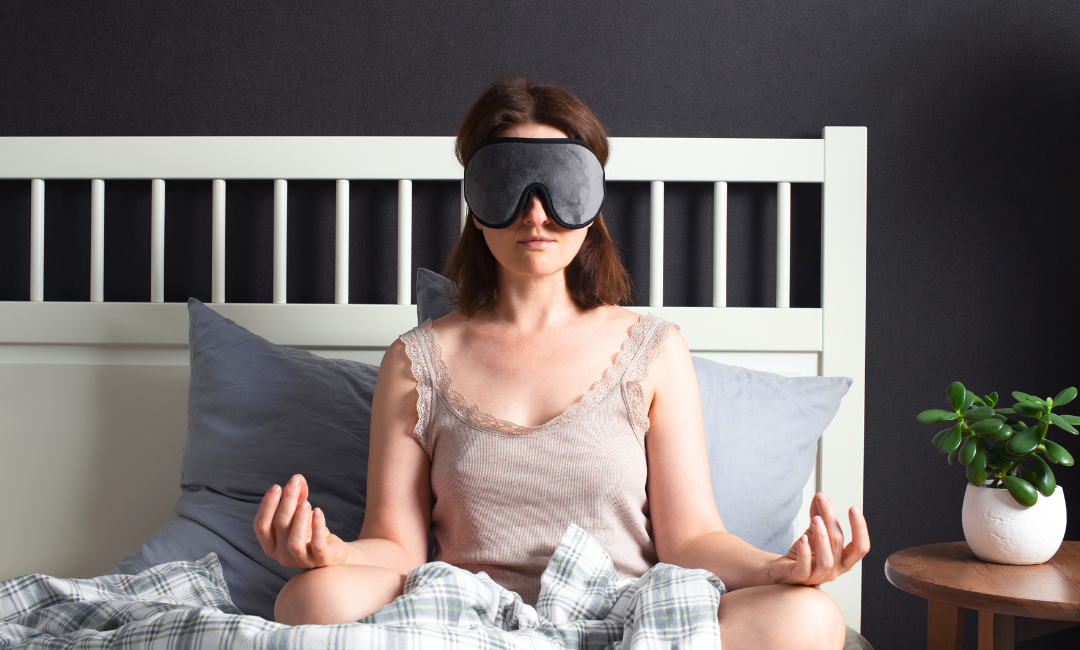Happiness consists of getting enough sleep. Just that, nothing more.” – Robert A. Heinlein.
Do you find yourself tossing and turning at night or have trouble staying asleep? Then, I think you are not alone. For most of us, this is a nightly struggle. In today’s busy life, very often at the end of a busy day, one finds it hard to get a restful sleep. The only way to relax your mind and body is to calm down the ever-busy mind so that the body can also relax peacefully.
We all know that sleep is imperative for our health and wellbeing. However, it is also important that we have consistent, uninterrupted, and quality sleep. Insufficient sleep augments our chances of stroke, heart disease, obesity, and depression. Getting proper and sufficient sleep is important for overall health.
If you are looking for a natural, no medication way to treat your insomnia or help you sleep better, then look no further! Yoga can help you not only if you suffer from insomnia, but can also improve your quality of sleep. Yogic asanas, meditation, and some simple breathing exercises done before sleeping can help relax the body and mind and also enhance overall calmness.
Yoga Nidra (Yogic Sleep or Psychic Sleep)
Yoga Nidra is a mind-body therapy that allows for deep relaxation and restoration. It is widely touted that 30 minutes of Yoga Nidra is equivalent to approximately 2 hours of deep sleep and can make you feel that you have slept for hours. Yoga Nidra is a guided meditation, in which the practitioners are instructed to breathe and relax in a certain way or may sometimes be asked to visualize sounds or images. The practice helps the practitioners to delve into deeper states of consciousness, which brings them into a state between sleep and wakefulness. Yoga Nidra can be done either as a restorative practice or before going to sleep. Yoga Nidra has been proven effective in chronic insomnia and can also improve your sleep quality.
Yogasanas
Viparita Karani (Legs-up-the-wall Pose)
This pose is a 100 per cent inverted pose, even though it is not as challenging as a headstand. This is a restorative pose that allows the whole body to unwind and relax. Viparita Karani can quieten the busy mind, improve blood circulation to the head, and relieve the tension that gets built up in the joints and muscles throughout the day.
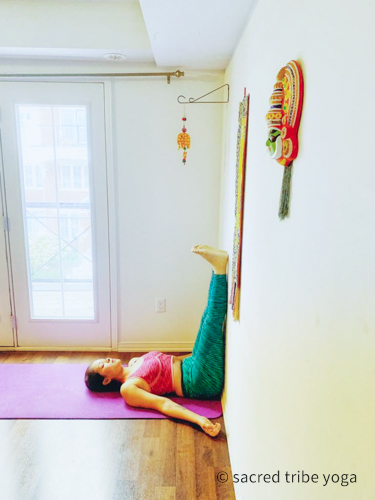
Instructions
1. Lie down on a flat surface positioning yourself in a way that your tailbone touches the base of the wall.
2. Keep getting close to the wall until your body forms an L-shape.
3. Hold the position for few minutes or as long as it is comfortable.
Tip
1. If you feel uncomfortable, place a towel at the base of your back or a pillow, or bolster under your head.
Shavasana (Corpse Pose)
Shavasana is not a sleeping pose so, try to stay present and aware during the time you practice it. Practicing shavasana before sleeping is an amazing way to slow down your mind and get more restful sleep.
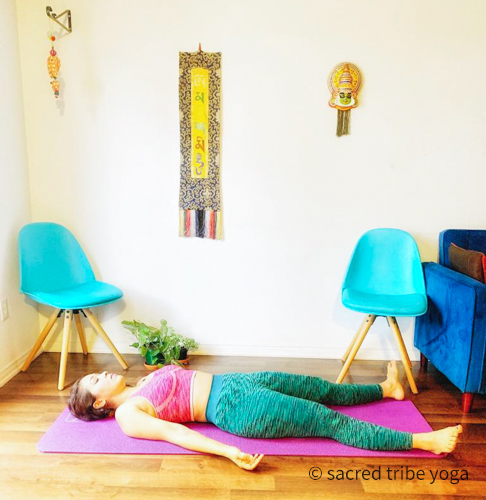
Instructions
1. Lie down on your back with your legs and arms relaxed at your sides. Your feet should be relaxed and hips-width apart.
2. Rest your palms facing upwards. Close your eyes and breathe naturally.
3. Now try to consciously relax each part of the body from the crown of your head to your feet.
Janusirsasana (Head-to-knee Pose)
Janusirsasana is a seated forward bend pose and can relieve stress, fatigue, headaches, and induce sound sleep.
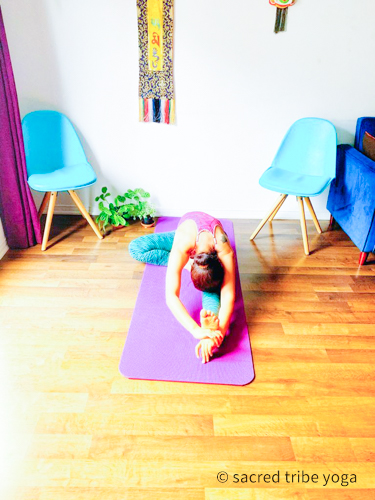
Instructions
1. Sit down on the floor with your legs outstretched. You can place a blanket under your hips.
2. Now bend your right knee, and place your right sole against your inner left thigh. Your right leg and knee should be pressed comfortably on the floor.
3. Inhale and extend both the arms up over your ears. Extend your spine by trying to reach your fingers to the ceiling and keep your chest lifted.
4. Maintaining the length along the spine exhale and start bending forward over the left leg. Let your hands fall wherever it is comfortable either on the shin, or the left foot. Don’t round your spine to move deeper into the pose. Try to reach the sternum to the left foot. Stay in the pose for 5 to 10 seconds.
5. To release, inhale and come back to an upright position.
6. Repeat on the other side also.
Tips
1. In case your hamstrings start paining you can put a pillow or blanket under your hips to give some lift and support.
2. If your hips feel too tight you can also put a bolster under the bent knee.
3. If it is difficult to reach for the foot of the extended leg, take a strap and loop it around the foot. Then pull it from both ends with your arms fully stretched.
Balasana (Child’s Pose)
“Bal” in Sanskrit means “child” and so in this posture, your body resembles a child in the womb. Balasana is another asana to let your mind and body snooze. Balasana is a perfect stretch your body deserves. It also helps you soothe your mind and hence gives you a good night’s sleep.
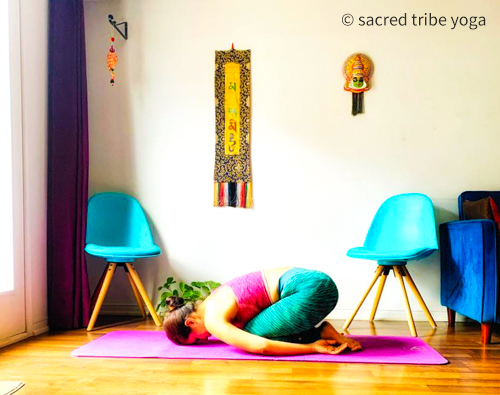
Instructions
1. Kneel on the floor and make sure your big toes touch each other.
2. After gaining some balance, spread your knees hip-width apart and slowly inhale.
3. As you exhale, bend forward lowering your forehead so that it touches the floor. You can either keep your arms alongside your body with palms facing up or reach out your arms towards the front of the yoga mat, with palms facing down.
4. Now gently press your chest on the thighs. Try to pull your tailbone towards the pelvis. Stay in the posture for at least 1 minute while breathing normally.
5. To return to the original position, place your hands under your shoulders. Inhale, and as you exhale, slowly raise your upper body.
Supta Jathara Parivartanasana (Supine Abdomen Twisting Pose)
Also called the spinal twisting pose, Supta Jathara Parivartanasana rejuvenates the body, relieves stress and fatigue, and helps you doze off quickly.
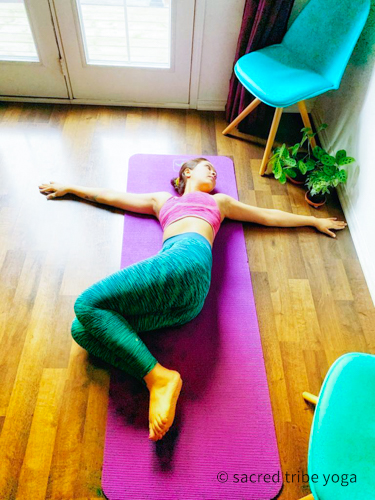
Instructions
1. Lie down on your back with feet on the ground.
2. Place your arms out on both sides with palms facing down in a T-position.
3. Inhale and bend your knees into the chest. Exhale and take both the knees over to the right side of your body, twisting the spine and lower back.
4. Stretch your left arm in opposition to your legs to help in the twist. Keep breathing normally and with each exhalation try to turn your abdomen to the left, away from the knees.
5. Keeping your shoulders flat on the floor, close your eyes, and stay in the posture for a few seconds.
6. To release the pose, inhale and bring the legs back up to the center.
7. Repeat on the left side also.
Tips
1. Don’t allow your knees to go below your pelvis, as this can put a strain on the lower back.
2. Don’t let your left arm and the shoulders lift off the mat. This can leave your neck, shoulder, and upper spine vulnerable to tension and strain.
Supta Baddha Konasana (Reclining Bound Angle Pose)
This is a hip opener and a relaxing pose. Supta Baddha Konasana is similar to Baddha Konasana with the only difference that it is done lying on the back.
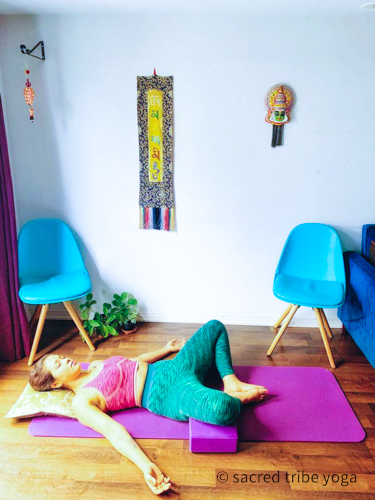
Instructions
1. Lie down on your back and bend your knees.
2. Make sure the neck is relaxed and the shoulders are not lifted off the floor.
3. Now open your legs out to either side and bring the soles of the feet together and allow your knees to relax away from each other. You can also put cushions underneath your knees to support the weight of the legs.
4. You can place your arms in any position – like overhead, on the side, or on the thighs, whatever is comfortable.
5. Inhale and as you exhale allow your knees to open up to create a good stretch in your inner thighs and groin. If you experience any pain, stop immediately. Try to stay in the pose for a few seconds. Breathe normally throughout the pose.
6. To come out of the pose, bring your legs together. Hug your knees and roll over to one side and with the support of your hands try to sit up.
Tips
1. You can lie back on a bolster or a blanket placed either along the length of the spine or crosswise, whatever feels best.
2. For complete relaxation place your palms facing upwards.
3. If you have any knee or groin injury then place blanket or blocks under the outer thighs for support.
4. Do not practice this asana if you have any knee, hip, or groin injuries.
Pranayama
Before you start doing pranayama, make sure the lights are dimmed and your phone off.
Brahmari pranayama
Brahmari is the Sanskrit word for “bee” and the sound that is made by this breath is similar to the buzzing sound of a bee. This breathing technique is known for reducing your breathing and heart rate. Brahmari pranayama has a calming effect on the mind and body and can help cure insomnia.
Instructions
1. Sit in a comfortable position. Close your eyes and keep your teeth and lips slightly open. This will allow the sound of the breath to be heard and felt distinct.
2. Now close your ears with your thumbs and place your index and middle fingers gently over your eyes between your inner eyes and the bridge of the nose. Put the ring fingers gently above your nostrils and your little fingers just above your upper lip.
3. Inhale through your nose and as you exhale through your nose slowly make a soft steady humming sound like that of a bee. This humming sound will make the front of your skull reverberate. Continue doing this for at least 5 minutes and slowly increase it to 10 to 15 minutes.
Tip
- Try to sustain the humming exhalation as long as it is comfortable. Don’t force yourself to maintain the buzzing sound, as it can cause even more stress.
Chandra Bhedana (Moon-piercing Breath)
Chandra Bhedana is also called moon piercing breath as it stimulates the cooling and calming energies of the right side of the brain. It quietens the brain and cools the body. After practicing Chandra Bhedana, you will feel relaxed and centered, and all set to get some good sleep.
Instructions
1. To practice Chandra Bhedana pranayama, sit comfortably with your spine straight and legs crossed.
2. Use your right-hand thumb to cover the right nostril and place the index and the middle finger on the forehead.
3. Now inhale through the left nostril and exhale also through the left nostril. If you are a beginner start with the ratio of 1:1 for inhaling and exhaling. So, if you inhale from the left nostril for 3 seconds exhalation should also be done through the left nostril for 3 seconds. As you progress, you can change the ratio of inhalation and exhalation to 1:2, which means if you inhale for 3 seconds, then the exhalation time should be 6 seconds.
Tip
- This breathing technique should not be practiced in winters and not on the same day as Surya Bhedana.
Ujjayi Pranayama (Breath of Victory)
Ujjayi pranayama or throat breathing is a form of controlled breathing that entails constricting the back of the throat while breathing. This breathing technique can also help you get sound sleep.
Instructions
1. Sit in a comfortable position and gently close your eyes.
2. Open your mouth a little bit and relax your jaw and tongue.
3. Start with a couple of regular deep breaths before transitioning to ujjayi breathing.
4. Inhale through your nose and exhale with your mouth open, engaging your throat muscles. As you exhale imagine you are fogging up a mirror in front of you with your breath. As you inhale your breath will make a “Sa” sound and on exhalation, you will hear a “Ha” sound. The combination of both sounds will create an ocean sound. Do it a few times to feel the glottis contract.
5. If you practice this breathing technique correctly, you can feel a natural contraction of the abdomen.
6. Focus on the sound of your breath and allow it to calm your mind.
Tip
1. Try to keep the flow of the ujjayi rhythm. But if you lose your rhythm, stop and slow down until you find the right flow of the rhythm.
The Takeaway
As you do this and you feel the tension in any part of your body, imagine sending your breath there and the tension exiting your body. You will surely fall asleep in no time and have sweet dreams!
These yoga asanas, breathing techniques, and meditation can help you nod off faster and wake up fresher. Practicing yoga before sleeping can mitigate restlessness and help you attain better and refreshing sleep. So, stretch and bend your way to a good night’s sleep with yoga and breathe fresh vitality into your weary souls!

